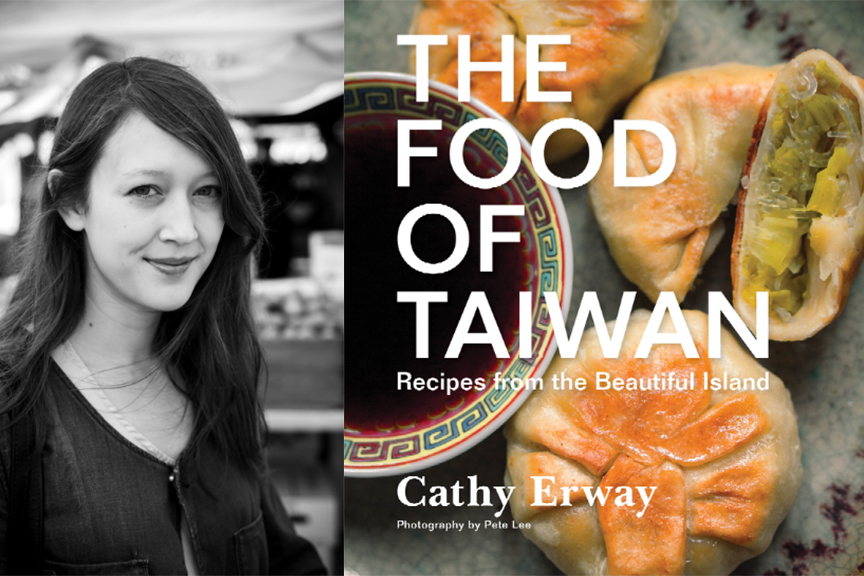Cathy Erway, the biracial Taiwanese American, New York-based food blogger, host of the podcast “Eat Your Words,” and author of The Art of Eating In, gets even more personal with her latest cookbook, The Food of Taiwan.
Bona fides: Erway grew up eating her Taiwanese mother’s cooking, but it all came together for her, gastronomically speaking, when she spent a college semester in Taiwan, eating her way through the country.
Authenticity quotient: With a helpful summary of Taiwan’s history, culture and diverse peoples, from aboriginals to Hakka, the book focuses on everything from traditional Taiwanese dishes to night market snacks to the unique dishes arising out of the military villages (juan cun).
Fun aside: Two pages devoted to explaining “Q” texture – that bouncy, springy texture that is a must in Taiwanese cuisine.
“Whoa” factor: Though there are no stinky tofu recipes here (“No one would want to stink up their entire home for weeks or months to make it,” writes Erway), she does have a recipe for pan-fried pork liver with sweet and sour glaze (jian zhu gan), which, she writes, may change your mind about this offal cut.
Must-try: Recipes for Taiwanese beef noodle soup, arguably its national dish, homemade crushed ice milk (also known as snow ice or shaved snow), and Taiwanese pork belly buns. Try out the recipe here:
Taiwanese Pork Belly Buns (Gua Bao)
Makes 8
Often translated as “Taiwanese hamburger,” this beloved street food has proven its international appeal. Popular variations are made by Taiwanese American restaurants like Fun Buns and BaoHaus in the States, and buns featuring its main component of red-braised pork belly (albeit with different toppings) is a specialty of the celebrated Momofuku restaurants. The classic Taiwanese version incorporates a hearty slab of pork belly along with picked mustard greens, fresh cilantro, and a dusting of crushed peanut powder. A compact bit of wildly contrasting flavors, textures, and culinary influences, it’s ultimately irresistible – and quintessentially Taiwanese.
8 sandwich-style steamed buns (found in the refrigerated section of Asian groceries)
6 to 8 tablespoons chopped picked mustard greens
8 pieces Red Braised Pork Belly (see recipe below), sliced about 1/2 inch thick
1/4 cup coarsely chopped fresh cilantro (stems included)
1/2 cup peanut powder
Steam the buns according to the package instructions. To assemble the buns, place a spoonful of mustard greens inside each bun, followed by a piece of pork belly. Top the pork belly with cilantro, followed by a pinch of the peanut powder. Serve immediately.
Red Braised Pork Belly (Hong Shao Rou)
Makes 4 to 6 small servings
1 pound pork belly
2 tablespoons vegetable or peanut oil
2 whole scallions, trimmed and coarsely chopped
4 garlic cloves, smashed
4 to 6 thick discs peeled fresh ginger
1/2 cup packed brown sugar
1/4 cup rice wine
2 cups water
1/2 cup light soy sauce
1/4 cup dark soy sauce
1 teaspoon five-spice powder
Remove any bone and cut the pork belly into thick pieces about 1 1/2 to 2 inches long.
Heat the oil in a large saucepan or wok over medium-high heat. Arrange the pork belly pieces in a single layer in the pan so that each piece has direct contact with the bottom of the pan. Cook without turning until just lightly browned on one side, about 30 seconds. Flip the pieces over and brown on the opposite sides for just 1 to 2 minutes more. Remove from the pan and set aside.
To the same pan, add the scallions, garlic and ginger and stir until just sizzling and fragrant, about 30 seconds. Add the sugar and cook, stirring, until bubbling, 1 to 2 minutes. Add the rice wine and bring just to a boil, stirring to incorporate the sugar. Add the water, light and dark soy sauces, and the five-spice powder and return to a boil. Return the pork belly pieces to the pan. Reduce the heat to a gentle simmer. Cover and cook until the pork is very tender and red stained, at least 1 hour, preferably 2 to 3 hours.
Recipes and photography from The Food of Taiwan by Cathy Erway. Copyright © 2015 by Cathy Erway. Photography © 2015 by Pete Lee. Used by permission of Houghton Mifflin Harcourt Publishing Company. All rights reserved.
Details Hardcover, $30, hmhco.com.








